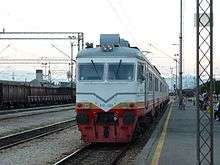Rīgas Vagonbūves Rūpnīca
Rīgas Vagonbūves Rūpnīca (RVR) is one of the largest machine-building plants in Latvia, founded in 1895 by the businessman Oscar Freywirth under the name Phoenix. RVR is based in Riga and was for many years the largest producer of electric and diesel trains and also tramcars in the former Soviet Union. Its best known products are the ER1, ER2, ER7 and ER9 electric trains, many of which are still in service today. Between 1973 and 1988 it built the high-speed ER200 train, and has more recently been involved in the refurbishment of units operated by the Latvian railway company Pasažieru Vilciens.

History
In 1936, Fenikss was reorganised into Joint Stock Company Vairogs, which later manufactured Ford-Vairogs automobiles under licence.[1]
Products
Trains
Currently under development is a family of new diesel trains under the name DR1B which will have a capacity of between 2 and 12 cars, and will be fitted with Euro3 standard engines and new power equipment. RVR currently oversees the refurbishment of older ER2 and ER9 trainsets, as well as the development of new products labelled ER22/29/35. The trains will be fitted out with newly designed interiors, built from layered plastic, aluminium panels and fibreglass. Customers will have the option of either a leather or fabric finish on passenger seats.[2][3]
Trams
Starting from 1923 to 1930, after postwar reconstruction the factory has produced some 40 tram cars for Riga city tramway. After World War II, in 1949 the factory started producing tram cars MTV-82. In 2002, RVR signed an agreement with the Mayor of Riga which will see the company replace the trams in Latvia's capital city once their period of operation ends in 2010. The new trams are set to offer enhanced comfort and safety, as well as being far quieter than the city's current fleet of elderly ČKD Tatra units. According to RVR they will feature bright and spacious interiors and will be 20-30% more power efficient than their predecessors. The new units are expected to be produced at a rate of 15-20 per year and will result in a gradual phasing out of the ČKD Tatra tramcars.[4] Until the early 2010s RVR built trams still operated in Daugavpils, Latvia's second largest city.
Current operators
Many RVR trains built during the Soviet period are still in active service across the former USSR. Current operators are shown below.[5] Very few, if any, RVR tramcars are still in operation, with most cities of the former USSR favouring tramcars built by ČKD Tatra.
| Company name | Country | Types in service (number) |
|---|---|---|
| Armenian Railways | ER2 (66) | |
| Azerbaijan State Railway | ER2 (74) | |
| Bulgarski Durzhavni Zheleznitsi | Class 32 (79), Class 33 (6) | |
| Belaruskaya Chyhunka | ER9 (57), DR1 (?) | |
| Georgian Railway | ER2 (?) | |
| Kazakhstan Temir Zholy | ER9 (77), DR1 (10) | |
| Lietuvos Geležinkeliai | ER9 (16), DR1 (14), AR2 (1) | |
| Pasažieru vilciens | ER2 (108), ER2T (23), DR1A (31),DR1AM (10), | |
| Željeznički prevoz Crne Gore | Class 412 (5) | |
| Makedonski Železnici | Class 412 (4) | |
| Rossiyskye Zheleznye Dorogi | ER1 (260), ER2 (1106), ER22 (66), ER200 (2), ER9 (617) | |
| Železnice Srbije | Class 412 (38) | |
| Ukrzaliznytsia | ER1 (?), ER2, ER9 (?), DR1 |
References
- Severstallat
- "Diesel trains". RVR. Archived from the original on 2011-07-22. Retrieved 2007-07-12.
- "Electric trains". RVR. Archived from the original on 2011-07-22. Retrieved 2007-07-12.
- "trams". RVR. Archived from the original on 2011-07-22. Retrieved 2007-07-12.
- "current operations". railfaneurope. Retrieved 2007-05-12.
External links
| Wikimedia Commons has media related to Rīgas Vagonbūves Rūpnīca. |